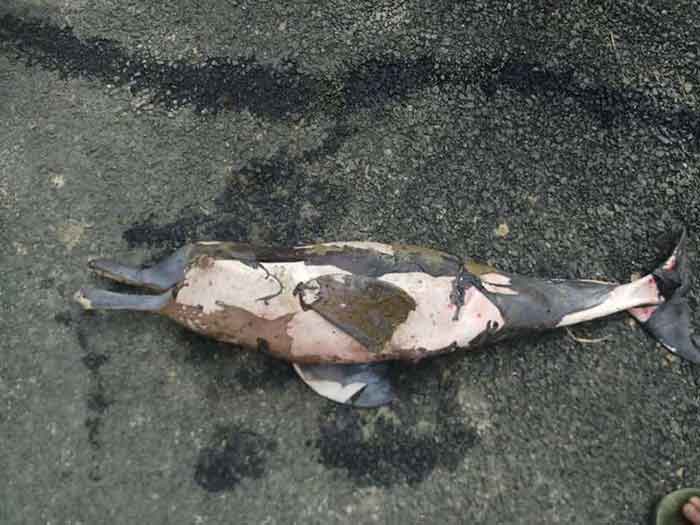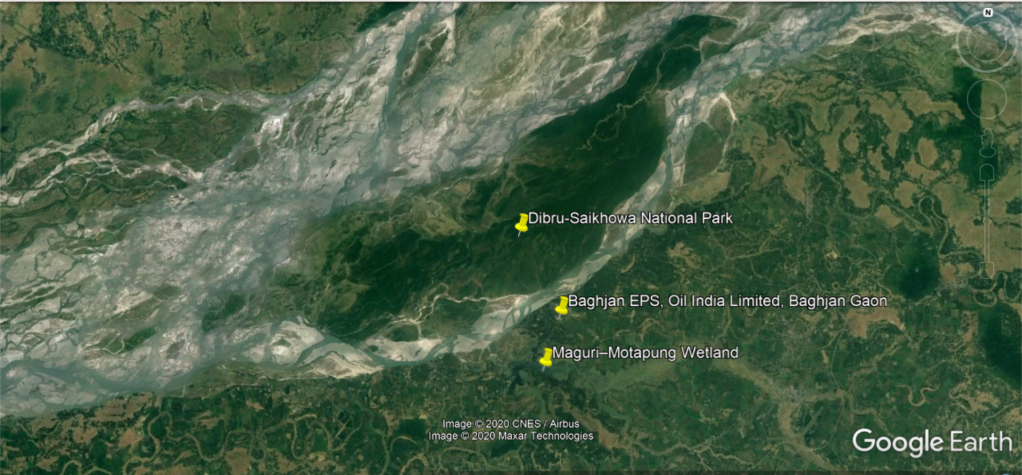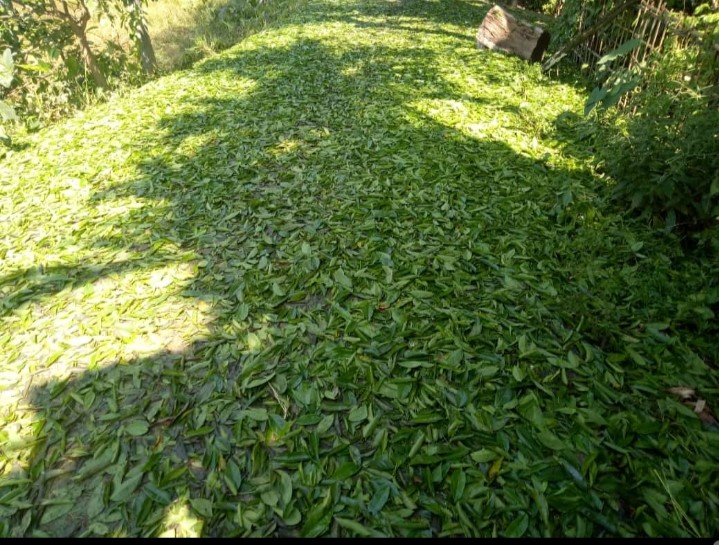by Niranta Gohain, KK Chattradhara, Manash Jyoti Chutia, Suraj Gogoi & Parag Jyoti Saikia

OIL were given environmental clearance to drill for hydrocarbons in the Dibru-Saikhowa National Park recently. On 27th of May a major explosion took place in one of its drilling wells causing havoc. This is a preliminary report on the event
‘The obligation to endure gives us the right to know.’
~Jean Rostand.
On the morning of 27th of May, around 10.30 am, 1785 people of Baghjan village under Hapjan Block of Tinsukia district witnessed their worst nightmare. Something was not right that morning. There was ‘alchemy in the air’ buried in those sounds. The villagers heard a series of booming metallic sounds erupting from a distance. The residents first thought it to be the sound of a jet plane or helicopter in the sky. Assam being prone to floods, and this year was not an exception, their first assumption was that a minister might have come for monitoring the flood situation in the area. However, they soon realised that the loud noise was coming from the drilling oil well site (BGR No 5) of Oil India Limited (OIL), and soon the spilling of substances thrown with great force into the air became visible to most people in the village. Sensing danger, people began fleeing the village. Some went to their friends and relatives and some took shelter in the village school premises. This was later turned into a relief camp. Till May 31st, approximately 800 families have taken shelter in the school which was turned into a relief camp. A detailed assessment has not been done yet.
After spending some nights of horror, some people were eager to return to their homes due to poor sanitary conditions in the relief camp. As the world battles through Covid-19 pandemic, maintaining safe hygiene has become very important. Keeping in mind the rising number of Covid-19 cases in the state, the district administration tried to shift some groups to different camps in order to maintain social-distancing.
Immediately after the blowout, the technicians working at the oil-well hurried to leave the site, but the villagers did not allow them to do so. The people were of course looking for answers and a solution to the major crisis that had just been laid bare to them.
Soon the Oil and Natural Gas Corporation technical team was summoned for help to help install a blow-out prevention system. It was assured by the Ministry of Petroleum and Natural Gas Corporation and OIL authority that the prevention system will work, but the blow out still continues. The effects of this blowout have left an irreparable damage to all kinds of life in and around the well.
However, the event of this blow-out only catalyzed the damages and destruction that was already brewing in and around the drilling area. The signs of the various effects of the drilling were to be noticed much before the blow-out. Even prior to this frightful incident, a flame burning continuously at the drilling well site had already caused a decline in the rate of pollination and migratory birds losing their routes or falling dead at the continuously burning flame. But the worst was yet to come.

Effects
Soon after the event of the 27th May, dense particles or condensates from the blow-out have turned the local atmosphere misty. Rain-like droplets have fallen on the vegetation leading to the formation of a sticky layer of oil. Initially, these impacts were seen in the 1 kilometer radius area of the well but now it has extended upto almost 2 kilometers.
For most of the families in and around the oil exploration site, fishing/fishery culture is the primary source of livelihood and oil residues suspended on the water bodies are already leading to disastrous impacts. Located in the 860 meters from the boundary of Dibru-Saikhowa National Park and 100 meters upstream of Maguri–Motapung wetland, the Baghjan area is crisscrossed by many waterbodies and a thick layer has already formed on these water bodies. As a result of the spillage, aquatic species have died in large numbers. These deaths can happen due to the oil floating on the surface of the water thus blocking oxygen and light. This disaster will also impact the future of aquatic species in the area as this happens to be the fish breeding season too.

The above of the dead carcass of a Gangetic river dolphin whose skin was peeled off has made rounds in social media. The condition of the dolphin is a testimony to the extent of the contamination and the dangers it carries. The Dangori and Dibru water systems are tributaries of the Lohit river, one major tributary of the Brahmaputra and their mouths are inhabited by this highly endangered river Dolphin.
The Baghjan oil spill poses a serious threat to the rich biodiversity of Dibru-Saikhowa National Park. Dibru-Saikhowa and the satellite areas are known for rich diversity of orchids and endangered animals, white winged wood duck (Deo Hanh), the Feral Horse and Hoolock Gibbons. It is now feared that this will lead to the extinction of many endangered species of flora and fauna and the environmental damage will be near irreversible.
The oil-spill also poses a threat to Maguri–Motapung Beel, a world-famous wetland. This wetland is a major source of livelihood for the villagers in the near vicinity and home to numerous species of local and migratory birds. The contamination of this wetland will spell doom for the livelihood of people living off fishing from the wetland and greatly affect the migratory patterns and density of bird species that live or visit the area.
Due to its unique ecosystem and rich variety of aquatic and bird species, this wetland is a paradise for bird-watchers and research scholars around the world. Due to this unique ecosystem a promising industry of eco-tourism and environmental learning with its rich diversity is already thriving in the area and this oil-spill will suffer gravely.
Even though the thick layer of oil on water bodies and on flora and fauna of the area is clearly visible, the actual extent of this oil spill still remains unknown. Therefore, the damage assessment to this oil spill must include loss of endangered species and the risk it poses for the overall biodiversity of the Dibru-Saikhowa National Park, Maguri Motapong wetland and its surrounding areas which now remains shockingly ignored. Moreover, we can only see what is visible to the naked eyes and the immediate effects that took place, however, the ‘delayed mortality’ in all life forms as Racel Carson alluded to will largely remain ignored.
This oil spill also increases the risk of skin infection. When oil sticks to plants and animals, the probability of bacterial, dirt and other substances sticking to it increases thus exposing them to infection. Imagine your hand being rubbed with oil and how easily dirt sticks to it. Same can happen to plants and animals, only that they can’t clean themselves.
The oil spill at Baghjan shows that OIL has failed to maintain any ethical and technical standards in its operations in the state. The callousness OIL has endangered the lives thousands of people at Baghjan, committed gruesome murder of endangered mammal like Gangetic Dolphin and other aquatic species and has erased a humbly balanced rural economy.
OIL’S complicity
OIL has failed completely to comply with conditions that were set in the environmental clearance it received in order to set up the drilling well in Baghjan that falls within the boundary of an eco-sensitive zone. OIL’s project named ‘Onshore Oil & Gas Drilling and Production in Mechaki Area covering Mechaki, Mechaki extension, Baghjan and Tinsukia Extension PMLs in District Tinsukia’ acquired environmental clearance. It is noteworthy that the OIL has claimed to tap into the hydrocarbons below the Dibru Saikhowa National Park without even entering it. OIL authority claims that it will use a state of the art technology called Extended Reach Drill (ERD). The ERD was glorified to be a safe technology which can create horizontal wells allowing it to reach the park even after drilling it from outside of the park boundary (4 kms approx from the existing drilling well plinth).
In the environment clearance issued by the Ministry of Environment, Forest and Climate Change (MoEFCC), OIL was required to follow the provisions under Water (Prevention and Control of Pollution) act, 1974; the Air (Prevention and Control of Pollution) Act,1981; the Environment(Protection) Act,1986; the Hazardous Waste Management Rules, 2016, the Public Liability Insurance Act,1991 and any orders passed by Hon’ble Supreme Court, High Court of Assam and any other Court of Law relating to subject matter. However, at the Baghjan oil-well, the company did not follow the conditions under environment clearance.
In paragraph XVIII of the Environment Clearance Report strongly directs the company to install a blow-out prevention system to avoid accidents during drilling operations. The company released a statement to the press in the aftermath of the oil spill at Baghjan where it claims that ‘all arrangements’, including adequate water spraying and installation of BOP (Blow Out Prevention) has been made to bring this spilling oil from the well under control. However, there is no way to confirm that BOP was pre-installed at the drilling site? If there was one, question arises why such a blow-out took place in the first place? It also raises questions about the continuously burning flame that existed even before the blow-out? This is a serious technical glitch on OIL’s part which also violates the conditions set out in the environment clearance report. However, such a major technical glitch is now attempted to be concealed under carefully framed public statements, such as “the producing well of Baghjan 5….. suddenly became very active while workover operations were on”.
Similar accidents of blow-out in OIL drilling sites was also recorded in Deohal Tea State located between Tinsukia and Duliajan, leading to the complete destruction of the well in 2011. Deohal reserves were identified in 1975 (drilled in 1976) but ‘the well was kept in abeyance for future market’. Prominent geologist on the Brahmaputra basin Prof. S.K. Lahiri along with his colleagues notes in their findings on the Deohal blow-out: “During the first decade of the 21st century, when the gas well was opened up again for exploitation, there was a blow- out due to unmanageable high pressure. The well was de- stroyed in December 2011. Reports of gas leakage started coming from different localities at different distances from the well since the beginning of 2012.” The map below shows the current blow-out site is not very far from the events of 2011 that took place in Deohal.

Even the immediate impact of the event in Baghjan has been enormous. Only a deeper search into the chemical compositions of the spillage will tell us the nature and longevity of the effects. Let us have a look at the effects it has left on its aftermath of the blow-out.
‘Alchemy in the air’
Since the oil spill has started in Baghjan, the residents of the area have complained of headache, irritation in eyes, skins and nasal passages at an alarming rate. This might have been caused by an early exposure to hydrogen sulfide, a poisonous gas often produced during drilling operations.The environment clearance report of this project mentions about the production of H2S during drilling and requires the company to develop a contingency plan for H2S release during evacuation and normal operations. The company did not develop any such plan.
The effects on plants and animals and the symptoms shown on the people living there shows that it may not just be a case of oil spillage which is causing these effects. A peep into how an oil drilling is conducted and the kind of chemicals used to carry out this process, with or without EDR helps us to locate the problems we are witnessing and probable dangers lying ahead.
Imaging you are digging a hole with a face-down shovel. As you keep digging to make way for the hole, you have to pull out the mud and keep it aside. Similarly, when drilling for hydrocarbons, the excavation machine drills 3000-4000 meters into the soil where the temperature is about 70-80 degree centigrade. Now, think of all the substances below the surface of the earth with rocks, water, mud and so on. The environment is also very volatile with gravity, temperature and pressure varying at different depths. Here, imagine getting your whole feet stuck in the mud. We get stuck as if the earth is holding our feet tightly. During the drilling of hydrocarbons similar jams take place due to suction force and various kinds of forces and pressure get created. In order to avert these pressures and ease out the drilling processes, various chemicals are used which are known as drilling mud or drilling fluids.
These drilling mud or drilling fluid are very important for oil exploration but they are also very dangerous at the same time. It is important for the drilling process as it helps to remove the cuttings (like those muds with the shovel), to control pressure, maintain stability of the drilling well and so on. The danger lies in the disposition of this mud which is considered as a waste of the drilling process. This waste mud is generally extracted to a waste pit that is dug out next to the well and covered by tarpaulin to avoid contamination of the soil and groundwater. This waste pit at once can contain the following things: caustic lignite, burnt oil or diesel, nitric acid, sulphuric acid, bentonite gel, sodium hydrochloride, and ammonia, among others.
Many of these chemicals in excess amounts are extremely harmful to human, animal and plant life. Some of them are also carcinogenic in nature. For instance bentonite gel used during drilling may contain variable amounts of respirable crystalline silica, a recognized human carcinogen. Ammonia, on the other hand, enters a human body through breathing, swallowing or skin contact. The New York State department of Health notes that ammonia in air can cause ‘immediate burning of the eyes, nose, throat and respiratory tract and can result in blindness, lung damage or death. Inhalation of lower concentrations can cause coughing, and nose and throat irritation.’ World Health Organisation (WHO) in 2005 noted that a single exposure intratracheal and injection of moderate amounts (0.16–0.27 g/kg of body weight) of finely powdered bentonite into rodents evoked long-lasting irritation of or damage to the lungs. Question also remains about what the interaction between chemicals will produce.
OIL did not take adequate measures to prevent spillage of hazardous wastes into the water bodies through designated drains and treatment facilities following which water bodies in the area have now been contaminated. The company was also required to adopt proven measures to mitigate chances of oil spilling and fire hazards, none of which have been adopted in case of Baghjan.
The turn of events reminds us of Rachel Carson and her wishful words:
“In this now universal contamination of the environment, chemicals are the sinister and little- recognized partners of radiation in changing the very nature of the world—the very nature of its life. Strontium 90, released through nuclear explosions into the air, comes to earth in rain or drifts down as fallout, lodges in soil, enters into the grass or corn or wheat grown there, and in time takes up its abode in the bones of a human being, there to remain until his death. Similarly, chemicals sprayed on croplands or forests or gardens lie long in soil, entering into living organisms, passing from one to another in a chain of poisoning and death. Or they pass mysteriously by underground streams until they emerge and, through the alchemy of air and sunlight, combine into new forms that kill vegetation, sicken cattle, and work unknown harm on those who drink from once pure wells.”
Dibru-Saikhowa has seen them all. As we celebrate World Environment Day, let the blow-up of Dibru-Saikhowa be a grim reminder of what human greed and nature of our consumption of chemicals can do. The effects left by the chemicals are also a reminder to what we have done to the environment. The event is indeed a grim reminder how the spectre of chemicals can haunt the world across many lifetimes. The effects shown in Baghjan are only the tip of the iceberg.
Conclusion:
The people of Baghjan and its nearby areas, who have been affected directly or indirectly by this oil spill, are currently staying in camps, hoping for immediate blocking of the leakage. This oil-spill poses direct threat to health, food availability and livelihood security in the area. The company should take the responsibility for the loss of property and livelihood of the people of Baghjan due to the oil spill and provide them immediate compensation. They should take full responsibility for the contamination of waterbodies and vegetation in the area and commit to cleaning up these areas as soon as possible.
Finally, this disastrous oil spill at Baghjan directs our attention to the larger question that arises here – Can Oil India Limited ever rebuild the rich bio-diversity of the Baghjan and larger Dibru-Saikhowa National park area lost for their greed on a profiteering industry? And that people are made to suffer and live with it, OIL and everyone who gave clearance to drill is answerable to the violence and destruction unleashed.
Author Bios:
Niranta Gohain is the General Secretary of Bahankhyam Unnayan Shakti and an entrepreneur who run eco-tourism camps in Dibru-Saikhowa National Park.
KK Chattradhara is a social activist and founding member of Peoples Movement for Subansiri Valley (PMSV), Assam. He can be reached at – [email protected]
Manash Jyoti Chutia is a writer and activist based in Assam.
Suraj Gogoi and Parag Jyoti Saikia are part of Pangsau editorial collective.
They can be reached at – [email protected]
Originally published by Pangsau.com
SIGN UP FOR COUNTERCURRENTS DAILY NEWS LETTER
















































